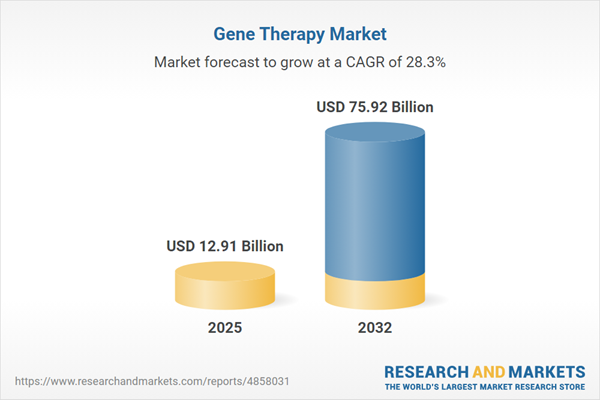Speak directly to the analyst to clarify any post sales queries you may have.
The gene therapy market is rapidly evolving, driven by deep scientific innovation and a growing need for precise, disease-modifying interventions. Senior executives seeking actionable insights and strategic direction will find this analysis an essential guide to today’s dynamic landscape.
Market Snapshot: Growth, Opportunities, and Trends in the Gene Therapy Market
The gene therapy market grew from USD 10.31 billion in 2024 to USD 12.91 billion in 2025. It is expected to continue expanding at a CAGR of 28.33%, reaching USD 75.92 billion by 2032. This robust trajectory reflects surging interest across rare diseases, oncology, and broader application areas. Advanced genome editing, an influx of capital, and accelerating regulatory approvals continue to fuel competitive activity and market expansion.
Scope & Segmentation: Detailed Coverage of Modalities, Technologies, and Regions
- Vector Type: Non-viral vectors (lipofection, plasmid DNA); viral vectors (adeno-associated virus, adenovirus, herpes simplex virus, retrovirus)
- Treatment Modality: Germline therapy; somatic cell therapy (gene augmentation, gene suppression)
- Target Genome: DNA modification; RNA modification
- Delivery Mode: Ex vivo; in vivo
- Route of Administration: Intramuscular, intraocular, intravenous
- Patient Type: Adult patients, pediatric patients
- Therapeutic Area: Cardiovascular diseases (coronary artery disease, heart failure); infectious diseases (hepatitis B, HIV); monogenic disorders (cystic fibrosis, hemophilia, sickle cell anemia); oncological disorders (hematological malignancies, solid tumors)
- End-User: Contract research organizations, hospitals and clinics, pharmaceutical and biotech companies, research institutes
- Geographic Coverage: Americas (United States, Canada, Mexico, Brazil, Argentina, Chile, Colombia, Peru); Europe, Middle East & Africa (United Kingdom, Germany, France, Russia, Italy, Spain, Netherlands, Sweden, Poland, Switzerland, United Arab Emirates, Saudi Arabia, Qatar, Turkey, Israel, South Africa, Nigeria, Egypt, Kenya); Asia-Pacific (China, India, Japan, Australia, South Korea, Indonesia, Thailand, Malaysia, Singapore, Taiwan)
- Company Analysis: Abeona Therapeutics, Adaptimmune Therapeutics, Adverum Biotechnologies, AGC Biologics, Alnylam Pharmaceuticals, American Gene Technologies, Amgen, AnGes, Astellas Pharma, Biogen, bluebird bio, Cellectis, CRISPR Therapeutics, Danaher, Editas Medicine, F. Hoffmann-La Roche, Gilead Sciences, Intellia Therapeutics, Ionis Pharmaceuticals, Johnson & Johnson, Merck KGaA, Mustang Bio, Novartis, Orchard Therapeutics, Poseida Therapeutics, Sangamo Therapeutics, Sarepta Therapeutics, Sibiono GeneTech, Syncona, ViGeneron, Voyager Therapeutics.
Key Takeaways: Strategic Insights for Senior Leaders
- Gene therapy is transitioning from a specialized field to a core pillar of the biopharmaceutical sector, supported by major scientific and capital investments.
- Technological innovation, especially in genome editing and modular manufacturing, is enabling more precise and safer therapeutic options across diverse indications.
- Strategic public-private partnerships and streamlined regulatory pathways are improving timelines and market access, driving collaboration among established firms and agile startups.
- Developers are optimizing supply chain models and evaluating domestic infrastructure in response to shifting trade and tariff environments, emphasizing resilience and risk mitigation.
- Segment growth is propelled by demand across oncology, cardiovascular, and monogenic disorders, as well as a focus on both adult and pediatric populations.
- Market entry and expansion strategies increasingly rely on differentiated vector platforms, advanced analytics, and integrated value-based approaches for sustained competitiveness.
Tariff Impact: Navigating Supply Chain and Cost Dynamics in the United States
Recent U.S. tariffs imposed on critical components—such as viral vectors and bioprocessing reagents—have raised production costs and created supply chain challenges. Companies are responding by localizing manufacturing, diversifying supplier bases, and forming new domestic partnerships. These shifts are prompting organizations to reevaluate procurement strategies in order to safeguard timelines and operational resilience.
Methodology & Data Sources
This report leverages primary interviews with executives, researchers, and regulatory leaders, alongside in-depth analysis of clinical trial registries, peer-reviewed literature, and public company disclosures. Triangulation and expert validation ensure objective, actionable results that inform critical decisions.
Why This Report Matters
- Enables senior leaders to make informed decisions by mapping key technologies, policy shifts, and emerging opportunities within the gene therapy market.
- Delivers critical segmentation analytics and competitor intelligence necessary for effective risk management and resource allocation.
Conclusion
The gene therapy market demonstrates significant momentum as technological, regulatory, and market trends converge. Senior decision-makers will benefit from strategic foresight to navigate evolving risks and capitalize on new growth frontiers.
Additional Product Information:
- Purchase of this report includes 1 year online access with quarterly updates.
- This report can be updated on request. Please contact our Customer Experience team using the Ask a Question widget on our website.
Table of Contents
3. Executive Summary
4. Market Overview
7. Cumulative Impact of Artificial Intelligence 2025
Companies Mentioned
The companies profiled in this Gene Therapy market report include:- Abeona Therapeutics Inc.
- Adaptimmune Therapeutics PLC
- Adverum Biotechnologies, Inc.
- AGC Biologics
- Alnylam Pharmaceuticals, Inc.
- American Gene Technologies Inc.
- Amgen Inc.
- AnGes, Inc.
- Astellas Pharma Inc.
- Biogen Inc.
- bluebird bio, Inc.
- Cellectis S.A.
- CRISPR Therapeutics AG
- Danaher Corporation
- Editas Medicine, Inc.
- F. Hoffmann-La Roche Ltd.
- Gilead Sciences, Inc.
- Intellia Therapeutics
- Ionis Pharmaceuticals, Inc.
- Johnson & Johnson
- Merck KGaA
- Mustang Bio, Inc.
- Novartis AG
- Orchard Therapeutics PLC
- Poseida Therapeutics, Inc.
- Sangamo Therapeutics, Inc.
- Sarepta Therapeutics, Inc.
- Sibiono GeneTech Co. Ltd.
- Syncona Limited
- ViGeneron GmbH
- Voyager Therapeutics Inc.
Table Information
| Report Attribute | Details |
|---|---|
| No. of Pages | 183 |
| Published | November 2025 |
| Forecast Period | 2025 - 2032 |
| Estimated Market Value ( USD | $ 12.91 Billion |
| Forecasted Market Value ( USD | $ 75.92 Billion |
| Compound Annual Growth Rate | 28.3% |
| Regions Covered | Global |
| No. of Companies Mentioned | 32 |









